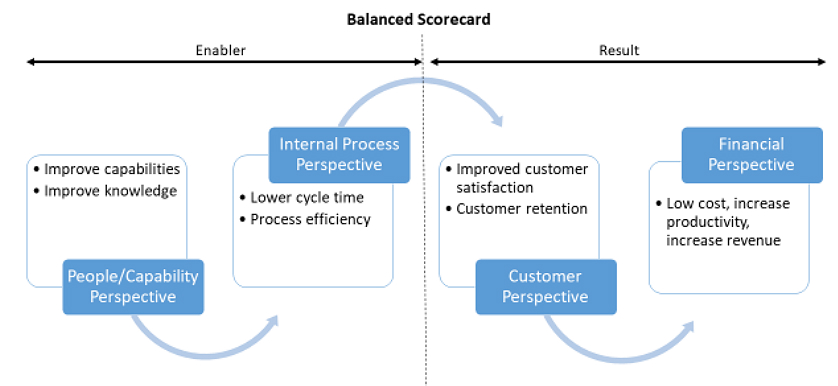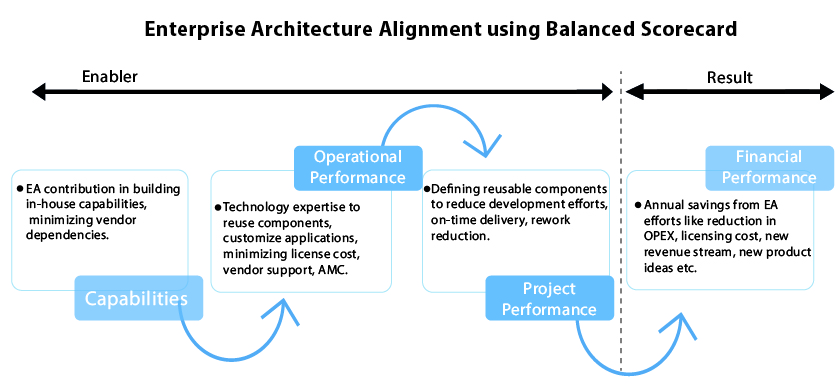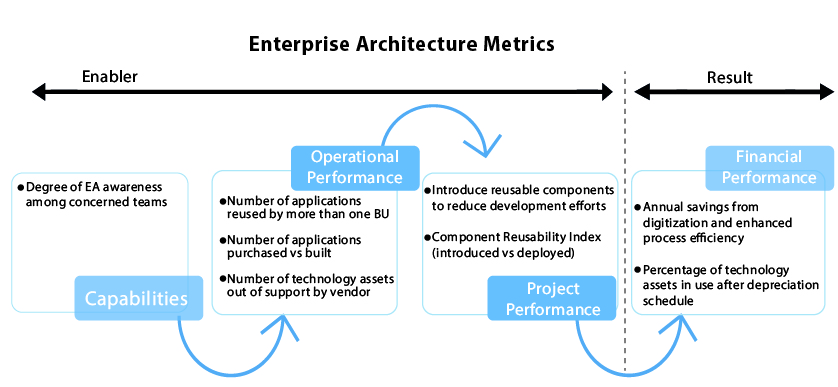A Business Perspective on the IT Enterprise Architecture, BSC and KPIs

Enterprise Architecture (EA) is a function used to perform enterprise analysis, design reviews & recommendations, and monitor its successful implementation through the use of a holistic approach that aligns with the business strategy.
Enterprise architecture applies architecture principles and practices to guide organizations through the business, information, process, and technology changes necessary to execute their strategies.
While many leaders realize the importance of EA, their focus prominently is on the internal activities of the EA program, rather than measuring how the EA program contributes to the organization achieving targeted business outcomes and financial objectives.
This brings us to the use of a worldwide renowned tool, the Balanced Scorecard, which is widely employed in defining business strategies across 4 critical aspects: Financial, Customer, People, Processes.
Using the same concept for EA not only enables leaders and Top Management to see how EA contributes to meeting business objectives but also helps the EA team to align their work with the corporate strategy.
- At the strategic level, EA can provide guidance on IT planning, investment priorities, and resource utilization.
- At the tactical level, EA is expected to enable businesses to mitigate development risks through guidance and the use of standards, best practices, benchmarking, etc.
The Balanced Scorecard (BSC) is a tool for defining and managing strategy, holistically. It is an approach to connect the dots between the Vision, Mission, Values to the next level of strategic focus areas like goals/themes and to operational elements such as objectives, KPIs, Targets, and initiatives.
The BSC links Business Enablers to Results. People and Internal Processes are the Enablers, which lead to Financial and Customer Results.

Aligning EA activities to corporate objectives enables Leaders to visualize the value brought by EA. BSC facilities can feel the same effect with 4 components under the direct influence of EA, as a contributor to the corporate BSC.
- Capability development
- Operational performance
- Project performance
- Financial performance

From a corporate perspective, EA Balance Scorecard-Enablers would build in-house capabilities, improving operational performance and adding value to projects, which would ultimately result in financial performance.
While EA is a critically positive function, because it has several benefits like improved business agility, reduced business & IT risks, cost optimization, technology-based innovation, it indirectly complicates your business objectives, which poses a challenge for many CIOs and CTO looking to establish the clear link between EA and business objectives.
This limitation must be recognized and addressed by understanding that business leaders don’t care about what the EA is doing at an operational level. Instead, they want to understand and, more importantly, measure how the EA program helps enable the organization’s future-state business capabilities, which in turn contribute to its financial performance.
Business leaders are the least interested to know how many architect reviews are performed or which technology is used; they are simply keen to find out how EA helps enable their business, to achieve its future state in the most cost-effective and efficient way, with sustainable growth, while building in-house capabilities. The EA – BSC alignment offers such details to business leaders.
Benefits of defining EA metrics
By leveraging EA metrics in a measurement program, IT practitioners and business stakeholders can evaluate:
- The visibility of degree of alignment between IT programs/projects with business strategies
- The tangible and intangible benefits of EA efforts
- The architectural risk and its impact on achieving business objectives
Important considerations to take into account while defining EA Metrics
- Define business-value EA metrics to demonstrate the impact of EA on monetizing targeted business outcomes and enabling businesses to achieve advantages over competitors.
- How EA efforts and deliverables impact technology-enabled investment decision-making.
- How EA can create new revenue streams
- How EA can support building in-house capabilities

Some of the Enterprise Architecture Metrics
- Capabilities
- Degree of EA awareness among concerned teams
- The number of patterns and standards developed
- EA awareness session – effectiveness
- Operational Performance
- Number of applications reused by more than one BU
- Number of applications purchased vs built
- Number of technology assets out of support by the vendor
- The number of patterns and standards utilized
- EA outcomes, including cost savings and cost avoidance due to process efficiency, technology standardization, retirement, and consolidation
- The percentage of reduction of repetitive data entry
- The percentage of increase in sharing of data via Web services
- Project Performance
- Percentage of architectural reusable components to reduce development efforts
- Component Reusability Index (introduced vs deployed)
- The percentage of reuse of common designs
- The percentage of projects architecturally aligned
- The percentage of reduction of development costs
- The number of projects that utilize approved designs
- The number of times an EA product or guidance is downloaded from the EA site
- The number of projects using EA guidance
- EA used to inform IT investment decisions
- The percentage of reduction in application development time
- Financial Performance
- Annual savings from digitization and enhanced process efficiency
- Percentage of technology assets in use after depreciation schedule
- The percentage of cost reduction associated with adopting enterprise-wide standards
- Cost savings through reuse of software components and standardized purchase agreements
- Total cost savings to investment as a result of EA
- Total cost avoidance to investment as a result of EA
Enterprise Architecture (EA) is an influential function, which enables the achievement of business objectives in a sustainable fashion. Aligning the EA function with one’s business strategy, by using the BSC and well-defined KPIs enables business leaders to recognize and appreciate the contribution of EA in achieving their desired financial goals in a holistic manner.
Image sources:

Tags: Balanced Scorecard, Business Strategy, KPI, Metrics





